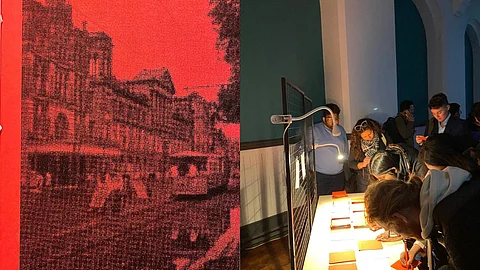
- HOMEGROWN WORLD
- #HGCREATORS
- #HGEXPLORE
- #HGVOICES
- #HGSHOP
- CAREERS
- ABOUT US
- CONTACT US

In the domain of urban planning, 'transit city' refers to a type of city designed around the use of public transport. In such cities, urban development is centred around public transport systems such as railways or tramlines. In the 19th century, the concept became popular in industrialised Western countries due to advances in transport technologies such as the steam train and the electric tram. In India, Kolkata was one of the first transit cities with its robust colonial-era bus and tram network. Ironically, the same tramways that once embodied Kolkata's industrial might, now represent its resistance to modernisation.
In Kolkata and Dublin-based artist and researcher Toshali Chattopadhyay's audio-visual installation 'The City At Ten Kilometres An Hour' — created in collaboration with artists Clara McSweeney and Mel Galley — Kolkata's slow-moving trams encapsulate the deeply personal and tender nature of public transport.
"If you have ever been to Kolkata — or even if you haven't — you'll know that it's a city that refuses to be hurried. It drips. It hums. It resists," Toshali says. "One of the best metaphors for that resistance is the tram. These slow-moving, slightly cranky but utterly charming vehicles are often dismissed as relics. But they are much more than that. They are memories on wheels. They carry the scent of childhoods, overheard conversations, political slogans, and stolen glances. For many Bengalis — myself included — the tram is not just public transport. It's public sentiment."
"Because transportation — particularly in developing cities — is not just about logistics and infrastructure," she says. "It's about identity, longing, urgency, romance, even disgust."
"Every commute is a story. Every journey is an archive of emotional states."
Toshali Chattopadhyay
The installation exists at the intersection of academic thought and creative expression. By embracing slowness, both metaphorically and literally, Toshali invites audiences to reconsider their pace, their cities, and the stories enmeshed within everyday movement through this audio-visual experience.
"The only way to really understand something so complex, so layered," Toshali says, "is to not just think it, but feel it. Slowness — the kind that a tram embodies — is a way of thinking, of observing, of refusing to be swept away in the current of so-called ‘development’. In a world that equates speed with success, maybe what our cities need is a bit of a slowdown. A ten-kilometres-an-hour kind of vision."
'The City At Ten Kilometers An Hour' succeeds where the prosaic language of higher academia fails. It cuts through the dominant mechanical, masculine, and emotionally sterile narratives about speed as a marker of infrastructure and modernisation, and embraces the tender, emotional landscape of public transport.
"Art speaks in a universal tongue. It doesn't demand that you ‘get it’ in order to feel something. It simply asks you to be present. And presence is political, especially in cities that are constantly trying to outrun their own histories in the name of progress."
Toshali Chattopadhyay
There’s also a subtle but potent critique of neoliberal urbanism embedded in the work. As cities across the Global South race toward tech-driven modernisation, the humble tram becomes a metaphor for what gets left behind — both materially and emotionally. Toshali doesn’t mourn this loss in a sentimental register; instead, she transforms it into a call to reconsider what counts as progress. She recasts the slow, old, inefficient trams as sites of care, attention, and resistance.
In many ways, 'The City At Ten Kilometers An Hour' is less a commentary on Kolkata than it is a prompt to rethink how we inhabit our cities, how we move through them, and what we lose when we equate speed with modernity. In a world obsessed with getting somewhere fast, the installation is a compelling argument for staying still, for listening, and for remembering that sometimes, the most radical gesture is simply to slow down.
Follow Toshali Chattopadhyay here.
If you enjoyed reading this, here's more from Homegrown:
purgatory EDIT: A Multimedia Installation That Questions The Vocabularies Of Violence
Below 2°: Experience A New Delhi Art Installation That Melts As the Planet Warms
Two Odd's Latest Installation Tells A Story Of Resistance & Survival Through Food
